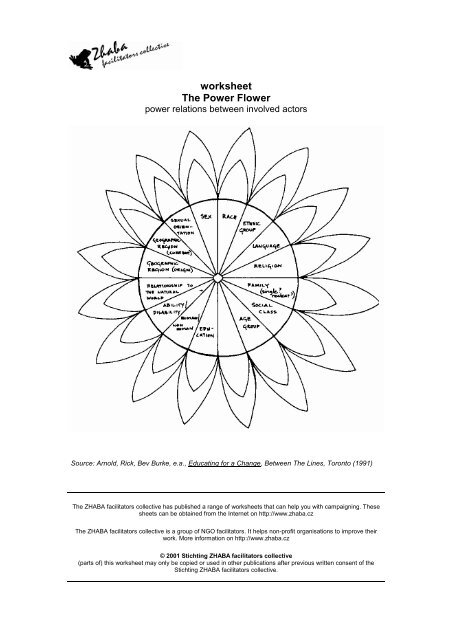worksheet The Power Flower - Zhaba Facilitator Collective
worksheet The Power Flower - Zhaba Facilitator Collective
worksheet The Power Flower - Zhaba Facilitator Collective
Create successful ePaper yourself
Turn your PDF publications into a flip-book with our unique Google optimized e-Paper software.
<strong>worksheet</strong><br />
<strong>The</strong> <strong>Power</strong> <strong>Flower</strong><br />
power relations between involved actors<br />
Source: Arnold, Rick, Bev Burke, e.a., Educating for a Change, Between <strong>The</strong> Lines, Toronto (1991)<br />
<strong>The</strong> ZHABA facilitators collective has published a range of <strong>worksheet</strong>s that can help you with campaigning. <strong>The</strong>se<br />
sheets can be obtained from the Internet on http://www.zhaba.cz<br />
<strong>The</strong> ZHABA facilitators collective is a group of NGO facilitators. It helps non-profit organisations to improve their<br />
work. More information on http://www.zhaba.cz<br />
© 2001 Stichting ZHABA facilitators collective<br />
(parts of) this <strong>worksheet</strong> may only be copied or used in other publications after previous written consent of the<br />
Stichting ZHABA facilitators collective.
Why use it? •<br />
Time it takes •<br />
To develop an overview of our target-groups (participants, and organizers /<br />
facilitators)<br />
90 minutes<br />
How to do it 1. Make a large drawing of the <strong>Power</strong> <strong>Flower</strong><br />
Fill in together the factors of power that might play a role during the process<br />
of this workshop.<br />
2. Fill in together the outer petals of the flower with descriptions of the group<br />
they expect to visit the workshop. Use characteristics as "high", "middle" and<br />
"low" and then indicate the amount of people that have that characteristic.<br />
3. Fill the position of the organizers / facilitators in (each in a different colour?)<br />
in the inner petals.<br />
4. Take a look at the position of the organizers / facilitators in the group. Look<br />
at:<br />
• Where will our position be different; which factors can be shifted or<br />
changed?<br />
• How can our position influence the group process?<br />
• Which facilitators need extra support or extra training of certain<br />
skills?<br />
Take a look at the division of power within the group of participants. Look at:<br />
• Will there be people with a very weak position in the group?<br />
• Will there be people with a very strong position in the group?<br />
• Can we expect tensions during the workshop?<br />
During the planning of the programme the <strong>Power</strong> <strong>Flower</strong> can hang on the wall<br />
and be used for reference. Especially when the first draft of the programme is<br />
ready, it is very useful to have another look at the <strong>Power</strong> <strong>Flower</strong> and see,<br />
whether there are any troublesome moments within the programme. Think of:<br />
- moments which are boring for a part of the group;<br />
- moments, where a part of the group can not participate actively , because<br />
others overshadow them;<br />
- moments where a part of the group will feel uncomfortable;<br />
- parts of the programme, where one of the facilitators will need extra<br />
support, because she/he is in a postion of low power (low authority)<br />
- etcetera<br />
2 Source: Arnold, Rick, Bev Burke, e.a.,<br />
Educating for a Change, Between <strong>The</strong> Lines, Toronto (1991)


